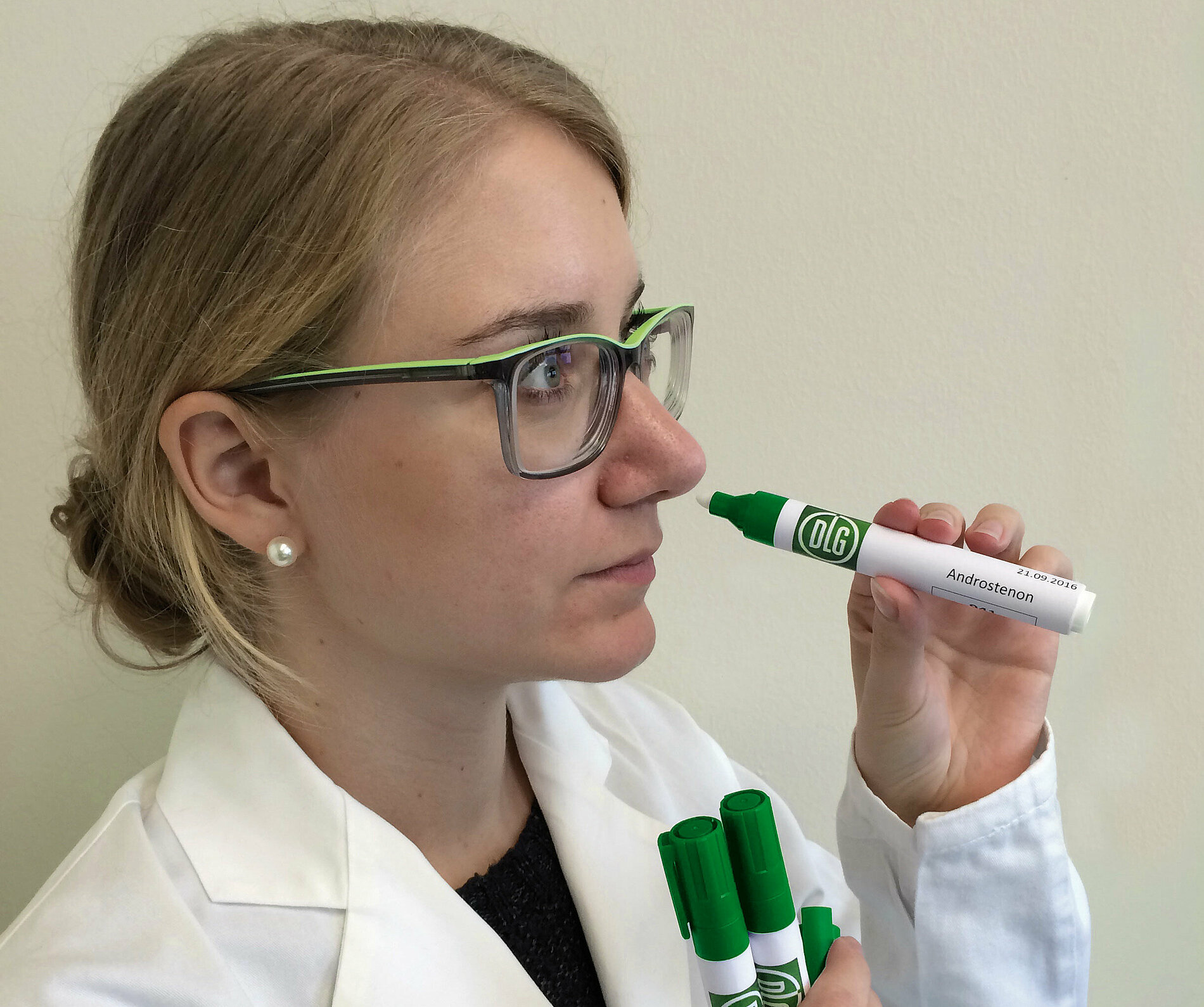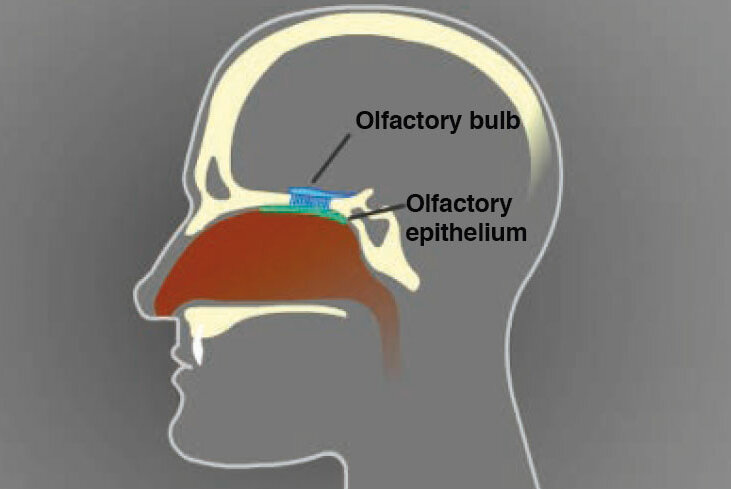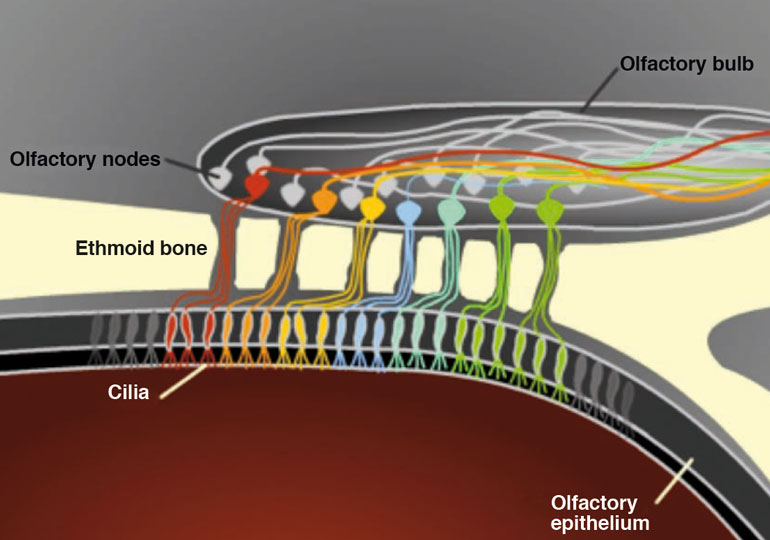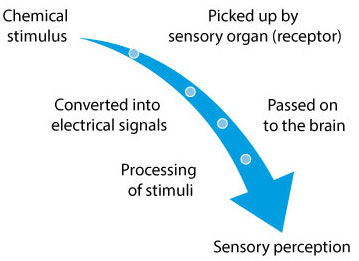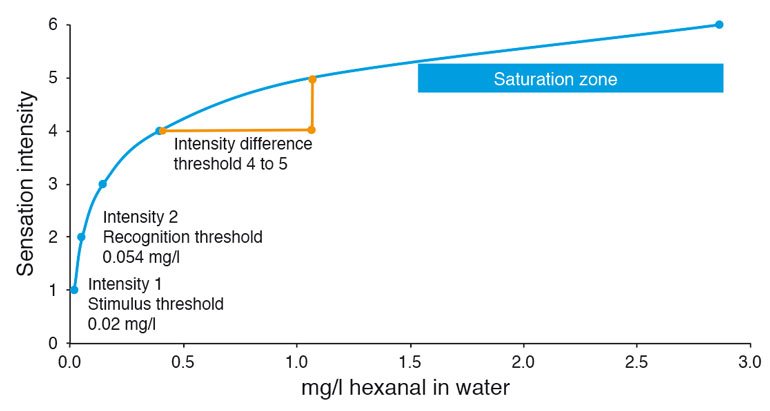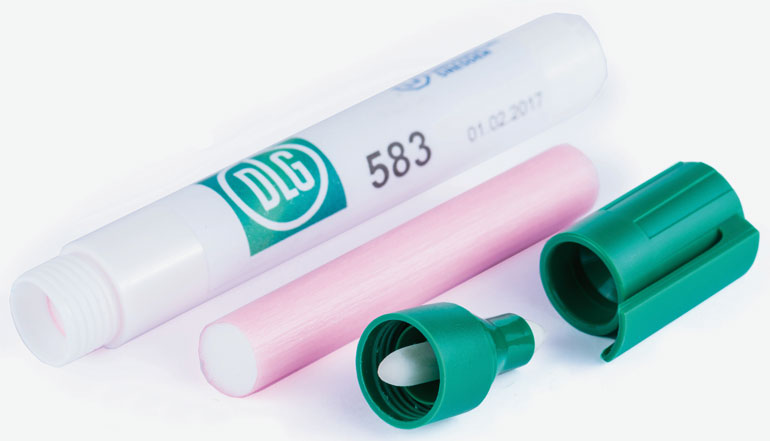Panel training on odour and aroma perception for sensory analysis
DLG Expert report 1-2017
Author:
- Prof. Dr. Thomas Simat, Chair of Food Science and Food and Skin Contact Materials, Technical University Dresden, Dresden
- Bianca Schneider-Häder, DLG e.V., Frankfurt/M.
- Marco Uhl, Bachelor graduate 2015, HS Geisenheim University, Institute of Wine Analysis and Beverage Research, Geisenheim, Supervisor: Dr. C.-D. Patz
- Martina Mleczko, Bachelor graduate 2015, Anhalt University of Applied Sciences, Department of Agriculture, Ecotrophology and Landscape Development, Bernburg; Supervisor: Prof. Dr. D. Hanrieder

The core of food flavour is formed not by the five basic taste types – sweet, sour, bitter, salty and umami – which are perceived on the tongue via the taste organ, but instead by the large number of substances and sensations that are perceived via the olfactory organ. These include both volatile odours and flavouring substances dissolved in the food (Legrum W., 2015, p. 26ff). In sensory analysis, the odour and aroma forms part of the spectrum to be analysed, alongside appearance, texture and basic taste. This Expert Knowledge Report aims to provide an insight into the training of odour and aroma perception in sensory analysis. This is because the perception of olfactory sensory impressions is a skill that panel members within sensory analysis need to train regularly. Although the complexity of the aroma perception (orthonasal and retronasal smelling) is explained, the focus of this Expert Knowledge Report lies on the training of the orthonasal smelling, i.e. the perception of volatile flavour compounds in the form of odours.
1. Introduction
Odour affects our life in many situations. Alongside the emotional and social aspect of odours, e.g. their influence on likes and dislikes, positively stimulating odours and aromas also serve to quicken the appetite, while off-aromas and odours help consumers to recognise dangers, for instance in spoiled foods. The different stimuli (totality of all gustatory, olfactory, haptic and trigeminal stimuli) perceived via the tongue and in the oral cavity during eating account for a relatively small part of the flavour. One central aspect is the odour of the dish, in other words the volatile compounds of its aroma. Before the first bite the nose tests how the dish smells and arouses various associations and emotions in the brain. Complementing this, chewing dissolves the soluble flavour compounds and allows the perception of the aroma via the mouth-throat-nose connection which finally leads to the product enjoyment in its full complexity. Through their sense of smell, humans can perceive, differentiate and recognise a large number of different odours. However, odour perception and recognition depend on experiences gathered in connection with various odours and on odour training.
Sensory food tests are an important component for ensuring high product quality. Sensory analysis comprises the testing of appearance, taste, odour, consistency and texture. In order to obtain the most informative results possible and a high degree of “measuring” precision in human sensory analyses, the tasks are carried out with a trained panel. Especially when smelling via the nose (olfactory sensory impression), untrained analysts find it difficult to recognise fragrances and odours perceived and to describe these in words.
This is attributable to the fact that in the case of odour we have not just five qualities of perception, as in taste, but instead it is possible to distinguish between a vast number of different olfactory impressions. These are caused by thousands of perceptible odour substances, which moreover can occur in any different combination. Classifying these odour impressions in odour groups at least is difficult and needs to be trained in order to be able to build on an odour memory.
2. Sensory physiology of the sense of smell
The sense of smell, also called the olfactory sense, serves to perceive aromas. Here we distinguish between perception of the odour of volatile substances by inhalation through the nose (direct smelling, orthonasal perception) and perception of aroma substances that are dissolved in the food and reach the olfactory epithelium in the nose via the mouth-throat-nose connection during exhalation (retronasal perception).
2.1 The olfactory and the nasal trigeminal system
The actual olfactory system in the narrower sense of the word and the nasal trigeminal system are involved in olfactory perception (perception of odour). These are two physiologically different systems. The olfactory system is localised in the upper area of the two nasal cavities in what we call the olfactory zone (Regio olfactoria) or olfactory mucosa. This covers about 5 cm² in each nasal cavity. Here there are around ten million olfactory receptor cells, each of which expresses only one of the around 350 different odour receptors. The nerve fibres leading out from these olfactory receptor cells grow bundled through the ethmoid bone (a spongy bone of the neurocranium) into the cranial cavity to the olfactory bulb (Bulbus Olfactorius), which can be considered an “offshoot” of the brain and from which the central-nervous processing of the odour stimuli begins (Fig. 1). (https://de.wikipedia.org/wiki/Olfaktorische_Wahrnehmung, Legrum W., 2015, S. 5ff.) Outside the Regio olfactoria, volatile substances can be perceived in the nasal mucosa through the nasal trigeminal system. Here the facial nerve “Nervus Trigeminus” transmits sensations such as burning, pungent, acrid, cooling in the nasal cavity (nasal trigeminal, volatile substances) and the sensations hot or sharp, tingling, cooling in the oral cavity (oral-trigeminal, volatile and non-volatile substances).

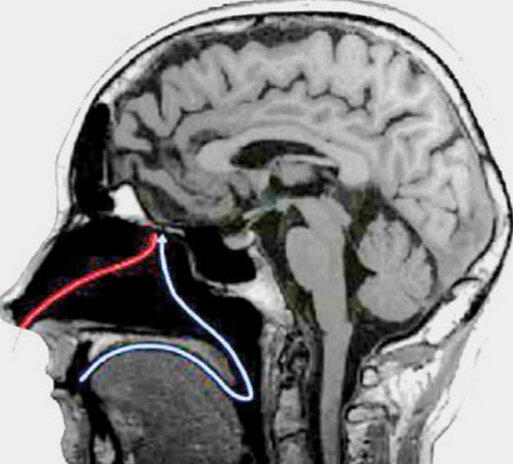
By contrast with the actual olfactory system, these sensations – except for the perception of hot and cold – are not perceived via specifi c sensory cells, but instead via free ends of nerve cells of the trigeminus nerve (Fig. 2). Many volatile substances trigger a sense of smell both in the olfactory system and in the nasal trigeminal system. These include volatile acids (e.g. acetic acid, butyric acid …), volatile pungent substances (including isothiocyanate from mustard, propanethial- S-oxide from onions, mucosa-irritating chemicals) and (pseudo-) cooling substances (menthol, eucalyptus oil). Carbonic acid/carbon dioxide on the other hand is an example of a substance that can only be perceived purely trigeminally (and not via olfactory paths in the narrower sense), and vanilla is perceived exclusively via olfactory paths. When humans inhale through the nose, the air fl ows through the nasal atrium, the nasal cavity and the various nasal passages until the odour substances interact with the olfactory receptor cells in the olfactory epithelium in the olfactory zone (Fig. 1). In sensory analysis a certain smelling technique is applied (frequent light sniffi ng), so that both nostrils can be activated at the same time and consequently the sensitive odour zones are reached better by the respiratory air (Derndorfer, p. 20ff.)
The volatile odour substances reach the Regio olfactoria as described before via the orthonasal perception track directly on inhalation or smelling of the food when it is taken into the mouth.
2.2 How olfactory sense cells and odour perception work
Odour perception (stimuli through volatile chemical substances) thus takes place via the olfactory system and the nasal trigeminal system. The senses of smell and taste belong to the chemical senses that are transmitted via molecules. Humans can distinguish between vast numbers of fragrances in many different concentrations and mixtures. Sensory perception can be divided into different steps, which are illustrated in Fig. 4. The odour substances pass via the orthonasal or retronasal path to the olfactory zone and there first of all to the olfactory mucosa with 10 to 30 million olfactory receptor cells. These display many tiny olfactory hairs (cilia) surrounded by mucus that contain the actual odour receptors (Fig. 1b). On its surface each olfactory receptor cell expresses only one of approx. 350 receptors still active in humans.
The sensophysiological operation of perceiving odours is also described as chemo-electrical transduction, because during smelling a chemical signal, namely the presence of odour molecules, is transformed into an electrical signal of the neural stimulus conduction. The central function in this context is fulfilled by the olfactory receptor cells that virtually serve as “interpreters”, as they master “both languages”.
As soon as odourant molecules have become dissolved in the mucus and reach the “docking places” (odour receptors), they interact with the matching receptors and trigger a cascade of signals in the cell, which ultimately leads to electrical impulses that are then passed on via the nerve fibres (axons) of the sensory cells to the olfactory bulb.
In this way the aroma information is translated from the chemical language into the electrical language. Generally the odour substances do not just interact with one of the around 350 odour receptors, but because of their molecular structure can also bond on a number of receptors. The activated olfactory receptor cells now transfer an electrical stimulus to the olfactory nodes (glomeruli) of the olfactory bulb. The olfactory bulb or bulbus olfactorius thus forms the first “odour station” in the brain and, as it were, collects the information from the olfactory receptor cells in small specific olfactory nodes (glomeruli). Rather like a “computer centre”, this activates various glomeruli and a particular neuronal pattern results for each odour substance. This is guided via further nerve cells to the brain, where new sorting and bundling are carried out. Finally, through linking with existing experiences and memories, odour perception and odour recognition take place.
However, all this leads to an infinite variety of odour impressions, for in the case of complex fragrances that can contain very large numbers of odour substances, very many olfactory receptor cells are activated at the same time to different levels of intensity and thus produce an unlimited variety of neuronal patterns (Legrum, W. 2015, S. 17ff; Bargs-Stahl, E. and Luck-Haller, E.)
3. Overview of aromas
3.1 Legal frameworks
In the European Community, aromas and food ingredients with aroma properties are regulated by the Flavouring Regulation (EC) No.1334/2008 and the associated Implementing Regulation (EU) No. 872/2012 (with the positive list of the chemically defined flavouring substances). Transitional provisions (EU No. 873/2012) apply with limitations up to 2018. See eur-lex.europa.eu/legal-content/
One of the goals pursued by the Flavouring Regulation is to protect consumers and ensure consumer health. The Regulation specifies what flavouring and source substances may be used in foods, what conditions apply for production of flavourings, and how flavourings are to be labelled. The natural and synthetic flavouring substances are tested by the European Food Safety Authority (EFSA) for their health safety. The flavouring substances that can be used are set out in the positive list in Implementing Regulation EU 872/2012.
Flavourings are defined as products that are not intended for consumption as such and are added to foods in order to impart or modify a particular odour and/or taste (Reg. EC 1334/2008, Art. 3, 2a).
Flavourings may be produced from or consist of the following categories:
• flavouring substances
• flavouring preparations
• thermal process flavourings
• smoke flavourings
• flavour precursors
• other flavourings or mixtures thereof
All the said categories are defi ned in the Flavouring Regulation as regards their production or extraction. Specific requirements are made of the use of the term “natural” (Art. 16, EU 1334/2008). According to the Flavouring Regulation, natural fl avour substances are substances that occur naturally and have already been detected in nature. They are produced using legally defi ned physical, enzymatic or microbiological methods. The source materials can be of plant (e.g. cell materials, fats, fruits), animal or microbiological (e.g. yeasts) origin. The natural fl avouring substances thus include, for example vanillin extracted from vanilla pods and biotechnologically produced γ-decalactone (peach-like). Up to the repeal of Directive 88/388/EEC in the year 2011, there were also the legally defi ned classifi cations “synthetic fl avourings” (fl avourings produced synthetically and not occurring in nature) and “nature-identical fl avourings” (synthetically produced fl avourings that occur in nature), but these are no longer used today.
3.2 Characterisation of flavouring substances
Various values serve to characterise fl avouring substances. Some of these are important indicators for human sensory tasting, but also for chemical-technical analyses. Only the most important of these are outlined briefl y below. When a food is consumed, all the senses work together and an overall sensory impression results. This contains not just the oral perception of texture, but also the sum of the non-volatile basic taste substances perceived via the receptors on the tongue and the volatile fl avouring substances perceived via the odour receptors and the nasal trigeminal system. The term fl avouring substance is used without involving any valuation, for the same volatile compound can be involved in the characteristic and pleasant flavour profile in one food, but as an “off-flavour” in another food so that this food can be rated as “not marketable” or as inedible.
Consideration of the fl avouring substance content in foods shows that although there are only around 10 to 50 mg volatile aroma-active compounds in one kg food, the number and diversity of the various fl avouring components is very high. If the products have also been treated for instance by fermentation or thermal processes, as in the case of tea and coffee, the number of volatile compounds can increase even further and fi nally amount to more than 800 different ones. Many of these compounds are present in a low concentration and therefore when taken alone are not very signifi cant for the fl avour. It is only when the concentration of the compound is higher than the recognition threshold in this food that the substance infl uences the flavour and aroma of the food.
3.2.1 Perception, recognition and differentiation threshold
The recognition threshold (identifi cation threshold, DIN EN ISO 5492:2009) describes the concentration of the fl avouring substance that is just enough to recognise or describe the odour (“recognised effect”). Alongside the recognition threshold, we also distinguish the lower-lying stimulus or perception threshold, which states the concentration at which volatile compounds can be perceived, but not yet recognised and/or described. (“not-yet-recognised effect”) (Busch-Stockfisch, Praxishandbuch Sensorik). Tabulated values for recognition thresholds of fl avouring substances in the air (determined by sniffi ng) and in water (determined by tasting of aqueous solutions) are frequently found in the relevant literature. They can differ from the odour threshold values of these aroma substances in specifi c foods (e.g. beer, yoghurt) by powers of ten due to matrix effects. Various infl uences, such as for instance the vapour pressure of the compound (variable depending on temperature and medium) or interactions with other odour substances (e.g. additive effects) play a role.
Changes in the concentration of a fl avouring substance (e.g. due to changing of the formulation or the production process, can influence the desired flavour profile of the product and be expressed in a changed product or odour perception. The same applies for the occurrence of foreign flavouring substances that thus lead to sensory product faults.
Furthermore, the difference threshold shows the lowest concentration difference that is necessary in order to perceive a difference (“just-enough effect”). It should be noted that the sensation intensity of a flavouring substance does not increase in linear fashion with its concentration, but instead in accordance with a logarithmic function (Weber’s Law, Fig. 5). Accordingly, starting from the stimulus threshold concentration, the hexanal concentration in water always has to be approximately tripled in order to reach the respective next higher – significantly distinguishable – intensity level. As the logarithmic curve flattens, a saturation zone develops for high concentrations and intensities, i.e. the concentration zone of a substance where any further increase in concentration hardly causes any further increase in intensity (“zero effect”). (See Busch-Stockfisch, Praxishandbuch Sensorik)
3.2.2 Key flavouring substances
Foods contain a large number of aroma-active substances that interact with each other and in their interaction trigger the sensory overall flavour impression in consumers. However, some foods contain key flavouring substances (character impact compounds) that largely shape the characteristic food flavour. Some examples of key flavouring substances are shown in Table 1. The aroma value (AW) can serve as a very rough estimate of the contribution of a flavouring substance to the overall aroma. The aroma value is an absolute measure. It results as a quotient from the concentration of a flavouring substance in the food and the odour threshold concentration of this same flavouring substance in the food (or water). (Belitz, Grosch p. 274ff.; Legrum W., p. 121ff).

Many products display value-adding aromas that are typical for them. In the same way product-typical off-flavours develop in the case of spoilage or quality defects. Both typical value-adding flavourings and typical off-flavours should be taken into account in product-specific odour training in order to build up an odour memory. However, it is notable here that as a result of the dependence of the olfactory notes on the flavouring concentration present, differing odour qualities can arise. This is not really noticeable in everyday life, as we always only smell the odour in accordance with the concentration in the food. For training purposes it should be noted that odour substances in lower concentration can display another, often more pleasant odour note than the same substance in higher concentration.
Alongside human sensory testing, instrumental methods of flavour analysis in particular play a significant role in identifying flavourings (see DLG Expert Knowledge Report 2/2015: Instrumental sensory analysis in the food industry – electronic noses).
3.2.3 Unambiguous designation of flavouring substances: IUPAC name and CAS numbers
Flavouring substances can be described unambiguously for instance via molecular formulae, CAS numbers and IUPAC names.
In chemistry, molecular formulae are used to show the nature and number of the atoms in a chemical compound (e.g. acetone: C3H6O). No definite substance allocation is possible with molecular formulae, as generally a very large number of substances display the same molecular formula, but have different structures. Even “trivial names” for substances are frequently not unambiguous. That is why standardised IUPAC names and CAS numbers are used to describe a substance unequivocally, even though this may frequently appear unusual for non-chemists.
The task of the IUPAC (International Union of Pure and Applied Chemistry) since it was established in 1919 has been to specify international standards for chemical nomenclature in order to thus achieve standardisation in the designation of chemical substances and ultimately to simplify and foster communication between chemists (from industry and academia) worldwide. The designations in other languages are correspondingly translated by the national associations of chemists, e.g. in the German-speaking region by the Gesellschaft Deutscher Chemiker (GDCh). One example of an IUPAC name is: trivial name “Acetone” – IUPAC name: “Propan-2-one”.
The CAS number (Chemical Abstracts Service-Registry Number) is an international designation standard for chemical substances. Since 1965, the Chemical Abstracts Service, an institution of the American Chemical Society, Ohio, USA, has allocated a distinct number to each chemical substance (including substance isomers or isomer mixtures such as racemates) and stored these in a database. Use of this comprehensive database that refers to every chemical structure on the basis of the CAS number is subject to a fee. CAS numbers are made up of three digits that are separated by two hyphens, for example: water – CAS No. 7732-18-5; ethanol – CAS No. 64-17-5.
Analytical characteristics
Substances and substance mixtures that are gaseous or that are vaporizable without decomposing can be separated chemo-analytically, for instance via gas chromatography (GC) and be detected using a flame ionisation detector (FID), mass spectrometry or olfactometry at an “olfactory detection port” (ODP). Depending on the detector, the odour description (at the ODP), the mass spectrum or the retention index can be used to identify the flavouring substances. The retention index (Kovats index, Kovats retention indices), is based on the relation between the retention times of n-alkanes and the retention time of a substance on a specific column material. It is thus characteristic for a sample substance on a specific GC column material (e.g. Ihexane: 600). Kovats retention indices of flavouring substances are partly available free of charge in databases on the internet (see www.flavornet.org).
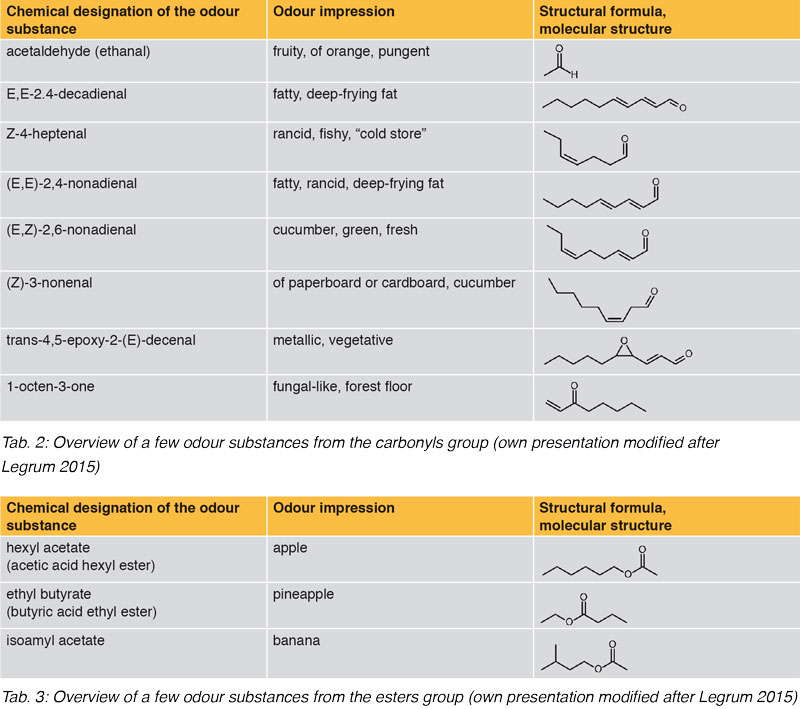
3.3 Flavour categories
(Individual) flavouring substances are chemical compounds that can be allocated to different substance categories or flavour categories depending on their molecular structure. These include for instance aldehydes and ketones, alcohols, acids, esters (and lactones), terpenes, pyrazines, phenylpropanoids, phenols and various sulphur compounds. Another way of classifying them is on the basis of their origin, e.g. as metabolic products, or formed by microbial fermentation in the foods (constitutive flavouring substances), as well as by the influence of heat (process flavourings). (Legrum, W., p. 103 ff.)
3.3.1 Constitutively formed flavouring substances
The constitutive or native flavouring substances are essentially described as those that occur in fruit, vegetables, spices and herbs through the plant metabolism or that are formed during harvesting, storage, drying or (e.g. enzymatically) after chopping/grinding/hacking. They can occur both as flavouring substances experienced as pleasant, or as (untypical) flavouring defects. Constitutively formed flavouring substances can be grouped on the basis of their structures. Some of the substances groups are set out below:
• Carbonyls (aldehydes and ketones)
• Esters
• Lactones
• Sulphur compounds
• Pyrazines
• Terpenes
• Phenylpropanoids
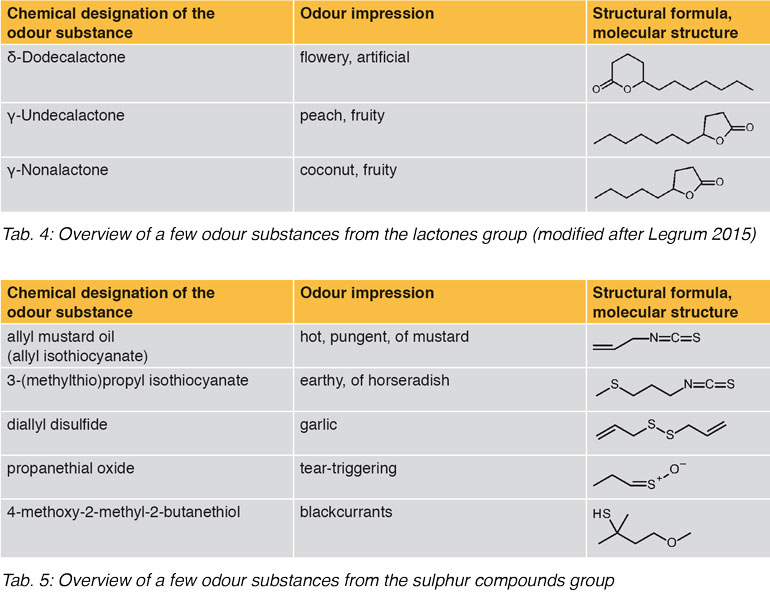
The first group, the carbonyl compounds, is made up of the degradation products of fatty acids formed microbiologically or enzymatically, the aldehydes and ketones. They result from autoxidation of unsaturated fatty acids with the involvement of the enzymes lipoxygenase and hydroperoxide lyase. In this way a large number of carbonyls result in fruit and vegetables from oleic, linoleic and linolenic acid. These display a low odour threshold and an enormous variety. Carbonyl compounds are formed increasingly under the introduction of oxygen, e.g. by cutting up fruits, which also promotes release of the lipoxygenases from cell compartments and development of the flavour.
Certain carbonyl compounds are described with descriptors that are more typical of off-aromas, such as rancid, fishy (Z-4-heptenal), metallic (trans-4,5-epoxy-2-(E)-decenal), cardboard-like (E-2-nonenal) or old. 1-octen-3-ol and 1-octen-3-one on the other hand are perceptible with a mushroom-like, earthy aroma already at low recognition thresholds (< 1 ppb). Acetaldehyde is one of the best-known representatives of the aldehydes and is important for the fresh, fruity note in orange juices. The odour of the pure substance is described as artificially fruity and/or pungent. Further known representatives are the short-chain aldehydes hexanal and (Z)-3-hexanal. They are formed by degradation of the linolenic acid and are responsible for green odour notes. These and further known flavouring substances from the group of carbonyls can be seen in Table 2.
Esters belong to the second substance group. They are formed from organic acids and alcohols with removal of water. The functional group formed from the reaction of the carboxyl group of a carbonic acid (-COOH) and the hydroxyl group of an alcohol (-OH) is characteristic of esters and is described by the general form R – COO– R´. In many fruits esters belong to the determining flavouring substances. They are formed in cellular manner in the plant from various alcohols and from activated (fatty) acids (Acyl-CoA). Apart from a few exceptions, the odour thresholds of the esters are frequently not particularly low (Legrum, W. p.105ff.). A well-known ester is the acetic acid hexyl ester (=hexyl acetate) which contributes substantially to the flavour of apples. A further well-known ester is the butyric acid ethyl ester (ethyl butyrate) that is co-responsible for the flavour of pineapples (see Table 3).
In chemical terms, lactones are intramolecular esters of hydroxycarboxylic acids (hydroxy fatty acids) and form the third group. Like the open-chain esters they occur in many types of fruit. Oleic and linoleic acid, which are specifically oxidised and converted into hydroxy acids, serve as the source substances for lactone formation. Through the β-oxidation, rings of different sizes form after the shortening of the fatty acids. Most frequently five-membered rings, the γ-(gamma) lactones, or six-membered rings, the δ-(delta) lactones result. Examples of this include the γ-undecalactone (lactone of γ-hydroxy undecanoic acid) and the δ-dodecalactone, which smell fruity, like peach or coconut respectively (see Table 4).
Sulphur compounds play a crucial role as flavouring substances, above all in vegetables, and form the fourth substance group.
Mustard oil glycosides (glucosinolates) are compounds containing sulphur and nitrogen that are formed above all by cruciferous plants (Brassicaceae). These include the cabbage varieties (e.g. cauliflower, Brussels sprouts, white cabbage, broccoli), rucola, garden cress, radish and horseradish. The mustard oil glycosides as undecomposed compounds are mainly responsible for the bitter taste of these vegetables. During the disintegration process the mustard oil glucosides are, however, partly split by released enzymes (thioglucosidase, myrosinase) into sugar (glucose) and the corresponding mustard oil (isothiocyanate).
These mustard oils are either non-volatile and are perceived orally-trigeminally as spicy, or they are volatile and then a pungent impression is added via the nasal trigeminal avenue. For example black mustard contains the glucosinolate Sinigrin, which is hydrolysed during chopping, chewing or boiling the mustard seeds to allyl mustard oil (allyl isothiocyanate). Amino acids containing sulphur and their degradation products characterise the flavour of plants in the leek family (Allicaceae), which include leek, garlic and onions. For example, after chopping garlic the amino acid alliin containing sulphur is degraded by the enzyme alliinase to form allylsulfenic acid, from which among other products diallyl disulfide smelling of garlic results via the intermediate stage of allicin.
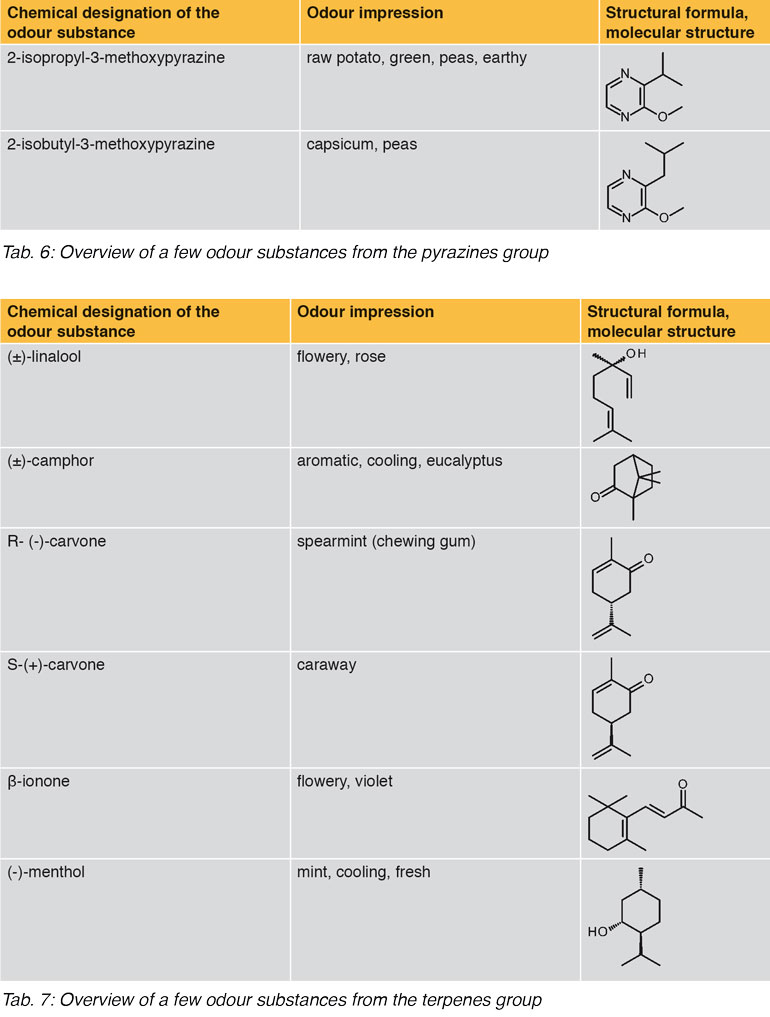
In onions, the tear-triggering propanethial oxide first develops from isoalliin through alliinase, which is further degraded to form dipropyl disulfide. (See Table 5) In addition there are sulfurous flavouring substances with extremely low recognition thresholds, such as the 4-methoxy- 2-methyl-2-butanethiol, which as blackcurrant can already be perceived as of 0.02 ng/l, but in higher concentrations then smells of cat urine.
Pyrazines also occur constitutively above all in vegetable varieties. A characteristic of this fifth substance group, which belongs to the heteroaromatics, is a ring scaffold with two nitrogen atoms. Pyrazines are responsible for the characteristic, green, vegetative odour notes in sweet peppers, chillies and carrots (see Table 6). Pyrazines play a major role as roasting flavours when foods are heated (see processively formed flavouring substances).
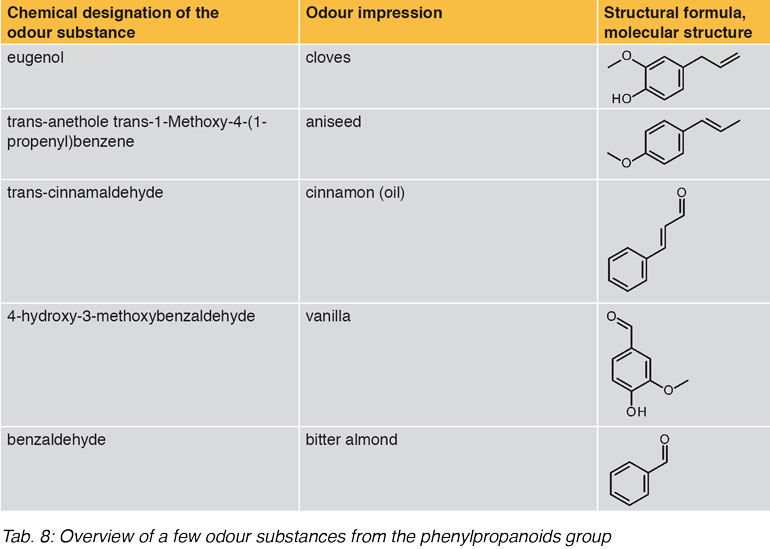
Terpenes are secondary metabolic products of plants and a principal component of the essential oils formed by these. They are frequently key flavours in fruit, vegetables and spices. In their chemical structure they are derived from isoprene (C5-rule) and are characterised by a large variety of carbon scaffolds and a lower number of functional groups. Depending on the number of the isoprene units joined together, we distinguish between hemiterpenes (C5), monoterpenes (C10) and sesquiterpenes (C15). So far over 8,000 terpenes are known. They occur in nature chiefly as hydrocarbon, alcohol, glycoside, ether, aldehyde, ketone, carbonic acid and ester terpenes. (See Table 7).
Phenylpropanoids are formed from microorganisms and plants via the shikimic acid path as secondary metabolic products with the amino acid phenylalanine as an intermediate product. The chemical basic body of this seventh substance group is phenylpropane, which can occur frequently substituted and modified. Alongside terpenes, phenylpropanoids are the main constituents of essential oils and can be key aromas above all in spices. Well-known representatives of the phenylpropanoid flavouring substances are vanillin, anethole, eugenol and coumarin. (See Table 8)
3.3.2 Processively formed flavouring substances
Processively formed flavouring substances are formed in the processing of foods and are also called process aromas. They are generally formed in thermal processes such as steaming, stewing, boiling, baking, roasting, deep frying or grilling. The influencing of the overall flavour/aroma by the process flavourings depends on their concentration and their odour threshold. The aromas can generally be perceived clearly during the above cooking processes. Alongside these substances with active odours, browning products also occur – the melanoidins that are crucial for the visual acceptance of foods (golden brown, burned-black). The process flavourings can be divided roughly on the basis of their formation reactions, but these may also overlap with each other:
• Maillard reaction
• Strecker degradation
• Caramelisation
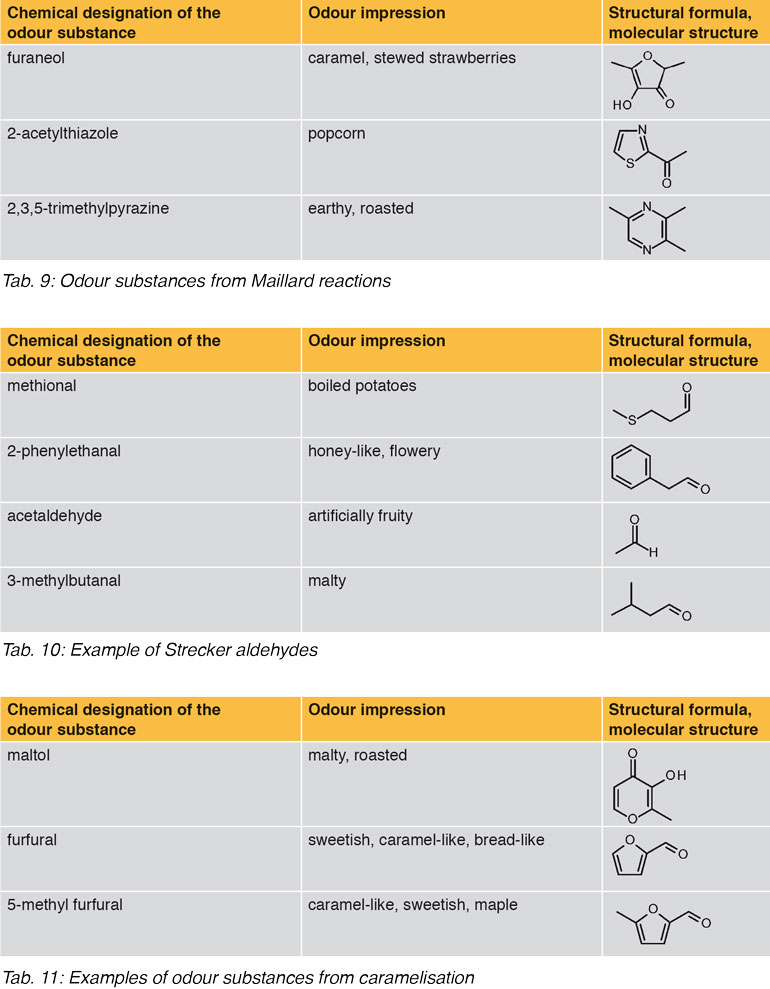
The Maillard reaction, a non-enzymatic browning reaction, is the most important of these. The source substances of this reaction are amino acids and reducing sugars (chiefly glucose, fructose, maltose and lactose), that react with each other under the influence of heat (as of around 120°C). A large number of reactions take place at the same time and after each other here, leading to browning and flavour formation. The material diversity of the resulting flavouring substances is very large, for example furanones, thiazoles, pyrroles and pyridines occur. Examples of these are shown in Table 9.
In the case of Strecker degradation of amino acids, a further important reaction in the formation of process flavourings, amino acids are desamined and decarboxylated under oxidative conditions. The products α-amino ketones and Strecker-aldehydes result from this, including for example the flavouring substances ethanal (acetaldehyde), 3-methylbutanal and methional (see Table 10).
Caramelisation is the third type of reaction leading to the formation of process aromas. Here monosaccharides or disaccharides (e.g. glucose, fructose, sucrose) are heated dry or under acid conditions until they dehydrate while browning. Flavour-active substances resulting from this are furane, pyrone and pyrane derivatives. Caramel is a typical product obtained by caramelising (see Table 11).
The volatile, flavour-active compounds are leading components of a flavour. It is not important whether they are formed constitutively or processively. They lend the food its characteristic flavour.

3.3.3. Aroma/Flavour wheels
Aroma and flavour wheels are standardised systems for sensory classification of flavouring substances, mainly with a reference to individual food groups. They aim to support the testers and analysts in perceiving, recognising and describing flavours. For this purpose overarching flavour groups (e.g. fruity) are linked with various sub-descriptors beneath them for specific flavours in this group (e.g. unripe apple). In this way they help a panel to find a common language regarding the verbal description of flavours. Odour references for the most important of these descriptors should be made available for training. Aroma and flavour wheels are available in standardised form for different product groups in the food sector, e.g. wine, bread, cheese, beer, coffee or tea. However they can also be tailored individually to the language of a panel for a product group. Recognised aroma and flavour wheels of a product group can be considered as standard for describing and identifying aromas and flavours and serve for comparability of sensory descriptions, thus making sensory analyses objective. The structure of the wheels, generally consisting of three concentric circles of sensory descriptors and references, follows a largely uniform principle.
• The various odour substances are first divided into aroma/flavour families or odour classes, which generally form the inner circle. Examples of these are flowery, microbiological, chemical, earthy, vegetal - vegetable, spicy, fruity.
• The middle – optional circle subdivides the aroma/flavour families into sub-families. Examples of these include flowery blossoms; vegetable; fruity – citrus fruit, berry fruits
• The outer circle contains the matching individual descriptors or attributes for the families or sub-families in the inner rings and a note concerning the matching references (e.g. fruity – berry fruit – raspberries, strawberries)
The panellist can then refine the description of sensory terms from the overarching classification right through to the outer circle and at the same time identify references for training. Figure 6 shows a cross-product aroma wheel from the DLG Basic Vocabulary which is oriented to the specifications of DIN EN ISO 8586:2014-05 “Sensory analysis: general guidance for selection, training and monitoring of assessors” and is suitable for basic odour training.
4. Flavours in odour training
By getting to know the different odour substances and training our sense of smell, we successively achieve improvement of the odour memory so that panellists are better able to identify and describe the odours perceived in words. Defined odour standards and sensory odour descriptions building on these can support this training measure. First of all the recognition threshold for an active odour substance is exceeded. By means of the memories stored in the odour memory it is possible to recognise and name the odour impression. With corresponding practice the intensity can also be assessed. Together with the memories odours trigger feelings too, so that they are subconsciously categorised hedonically as well. Odours in the context of experience and learning situations can be remembered particularly well with emotional participation.
In professional sensory assessment of foods, the odour is best registered by sniffing several times. In this way far more respiratory air passes through the nose to the olfactory epithelium than in the case of normal breathing. Furthermore, after each odour test the nose and the olfactory system need to be neutralised so that after this it is then possible to perceive the next odour by sniffing. Neutralisation can be carried out by brief smelling of a lemon juice solution (provided the analysts are not testing citrus products and fragrances), by smelling a small glass container filled with coffee beans, or by sniffing the analyst’s own body smell, e.g. in the elbow joint. Furthermore, “sniffing” of the odour substance should not take too long, because in the case of certain substances the olfactory system adapts relatively quickly, or if the small glass containers are open for too long the odour substance dissipates (drop in concentration), which makes odour recognition more difficult.
Generally the composition of the food flavours is very complex and only real foods can be used in training in order to cover their interaction with other substances comprehensively, so that at an advanced stage of odour training we frequently work with food samples. However, at the start of analyst training and also to get ready for a test we use flavours or key flavours that are available as isolated individual substances or substance mixtures and are thus easy to recognise and describe in words. The odour memory and verbal powers of expression can be trained with the help of standardised odour references with set concentrations, the typical odour quality of which should ideally be clearly recognisable for all analysts.

4.1. Examples of individual flavours for odour training
The following overview lists individual flavours that are suitable for odour training. They are based on proposals of DIN EN ISO 8586:2014-05 and in addition include key flavours and off-flavours occurring in many food groups taken from the DLG Basic Vocabulary.
Food flavours
The training substances listed in the following Table 12 with their respective odour characteristics fall under the category of food flavours for training purposes. Each flavouring substance possesses specific properties. These include e.g. their occurrence in foods and the description of the odour impression.
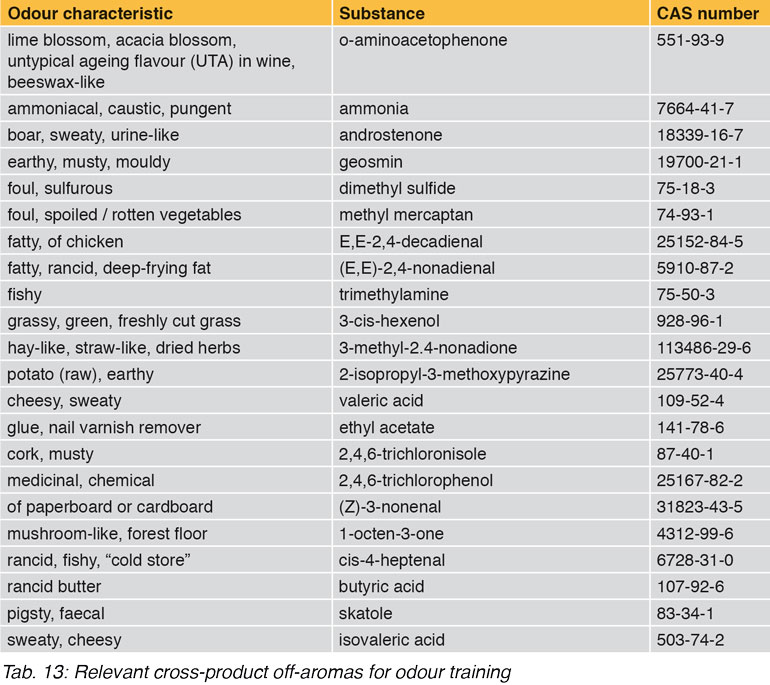
Off-flavours
Possible substances in the category of off-flavours that frequently give foods the impression of quality defects are listed with their odour characteristics in Table 13.
4.2. Forms of offering and presenting odour substances
The offering of aromatic substances depends on the nature of the flavour training session or test. Generally, the intensity of the odour references should lie well above the odour identification threshold of the analysts. However, the intensity should not be chosen too high, as with some flavouring substances the aroma impression changes with increasing intensity and can influence other analysts sitting close by.
Depending on the objective, we distinguish between two methods of preparing samples. In the retronasal test the odours are assessed via oral intake of an aqueous solution. In the case of a direct orthonasal odour test via the nose, carriers such as e.g. small glass vessels, smelling strips or capsules as well as sniffing sticks that contain the odour substance are used. The odour substance must have been prepared beforehand in a stock solution. Ideally, industrially produced flavouring substances that are suitable for preparing defined odour samples with high reproducibility on the grounds of their standardised quality are used to prepare the stock solutions and the odour standards. Generally ethanol (undenatured alcohol), propylene glycol, triacetin or glycerine are used as solvents for flavouring substances. The stock solutions made in this way can be kept cooled and protected against light for around six months before they gradually lose their intensity and their odour impression. In the case of ethanol, its inherent odour must be taken into account, so that generally this solvent is not used for handing out in small glass vessels or as sniffing sticks.
According to DIN EN ISO 8586:2014-05, “the most-used method […] for training the sense of smell is still the presentation of odour-active substances in glass vessels.” For training odour recognition of standardised flavouring substances, odourless brown (colour-masking), sealable glass containers are accordingly first provided with odourless paraffin wax or odourless cotton wool, to which the odour solution is then applied so that the carrier substances is saturated with the aromatic substance and this then evaporates into the gas headspace of the sealed glass vessel. To test the smell the lid is then opened and the odour substance that has “evaporated” in the headspace can be registered in sensory terms by careful brief sniffing. Furthermore, food products such as e.g. apples or spices, extracts or infusions covered by odourless cotton wool or paraffin wax in a suitable, vision-proof and sealable glass vessel can also be used.
A further possibility is the uptake of the aromatic substance via a paper strip that is dipped into the odour solution for the odour test.
If industrially produced flavour capsules that contain the standardised odour reference are used, powdery, nano-encapsulated flavourings can be integrated directly into the product matrix or “processed” to form stock solutions for odour training sessions. No special laboratory skills or equipment are necessary for this. (See www. aroxa.com)
Sniffing sticks are another very convenient solution for odour training. In principle, sniffing sticks are fibre sticks filled with flavour/aroma solutions (comparable with the well-known “Edding®” pens). The solutions of the odour substances are injected in a standardised concentration into the fibre material of the filter, so that these are completely saturated. The filter is then inserted into the shaft and screwed together with the mouthpiece (see Fig. 7). The fibre stick in the mouthpiece is pressed into the saturated filter as it is screwed and thus conveys the aromatic solution to the external tip. To protect this against drying out, the stick is closed with a cap.
To sniff the odour sample, the cap is drawn off carefully (DO NOT unscrew!!!), and the stick is held with the fibre tip directly under the nose so that the aroma impression can be absorbed carefully by sniffing. The stability of the sticks depends on the frequency of use, proper handling and proper storage. Highly volatile aromas (e.g. ammonia, acetaldehyde) or aromas subject to oxidation (e.g. benzaldehyde) are less stable. Generally, however, a stability period of at least six months can be assumed. Experience acquired to date has shown that keeping the sticks in a cool (approx. 5°C) and dark environment (e.g. refrigerator) is optimal for maintaining quality. Furthermore, after each use it should be ensured that sticks have not been unscrewed at the shaft by mistake.
5. Possible uses of odour substances for panel training
The European standard DIN EN ISO 8586:2014-05 represents a guide for selecting, training and monitoring selected testers and sensory analysts. This standard describes the goal of panel training as follows:
“[…] equipping test persons with fundamental knowledge of the methods used in sensory analysis and developing their ability to perceive, identify, describe and distinguish sensory stimuli.” [p. 15ff.]
Various methods and processes can be used to train perception and identification of flavours and off-flavours. As already described, all training measures for aroma recognition by panellists focus on developing a long-term sensory memory which is then able within the context of sensory testing to connect the odours being registered with what has been learned or with earlier experiences and to finally supply plausible, reliable test results.
Before the test persons for the targeted test (sensory analysis project) can be trained in accordance with the recommendations of this guide, it is first necessary to recruit potential panellists, above all persons interested in objective assessment of foods. This is followed by preselection with examination of the sensory capabilities of the recruits. Furthermore, the candidates are familiarised with the methods of sensory analysis and the products and materials to be tested. The selection of the tests and the material depends on the planned field of application of the panel and the properties to be evaluated.
Generally these sensory tests are divided into three different sectors. The first sector determines deficits and weaknesses of odour perception on the grounds of physiological limits/impairments (anosmia – impairment of the sense of smell) and the sensory sensitivity of the sense organs. Accordingly this establishes general suitability of a person for conducting sensory tests.
In the second sector the capabilities of the individuals for identifying odours, differentiating odours and qualities and describing odours are examined. The latter is particularly relevant for descriptive panels who have to be trained regarding their linguistic ability to describe odours.
In the third sector odour sensitivity for selected substances or substance mixtures is tested. This is relevant for panels who have to identify an off-flavour or certain value-adding flavourings as sensitively as possible. Furthermore, the ability to distinguish between slight intensity differences of an odour is tested, as this represents the requirement for evaluating the intensity of an odour.
Building on the above specifications, the following sections aim to provide an insight into various possible ways of providing odour training and orthonasal flavour training. Alongside the selection of test persons, these sensory tests can also be used to train/prepare them for test tasks and to monitor the quality of the analysts. Each panel leader must specify the nature and number of tests individually, rather like a modular system. Beyond this, further details of the methods discussed here can be taken from the respective DIN EN ISO standards.
5.1. Registering physiological impairments and weaknesses in the sensitivity of odour perception (screening test)
Screening tests based on odour substances are used to identify specific anosmia (inability to perceive odours, e.g. non-smellers of androstenone) or reduced odour perception, for instance due to ageing or as a result of disorders of the olfactory system. These are generally conducted during the preselection of test persons and aim to contribute to “screening out” persons with sensory-physiological deficits, so that incorrect assessments due to non-recognition of the stimuli can be ruled out in the analyst panel. The screening generally relates both to the qualitative flavour identification and to perception of flavours in a low intensity close to the identification threshold. This suitability test mainly consists of a number of tests that can partly also be combined with one another.
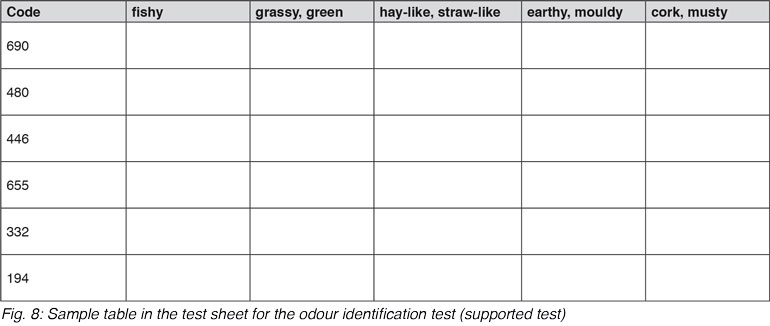
5.2 Tests of the ability to recognise and describe odours
As already mentioned, building up an odour memory is relevant above all for members of a descriptive panel, as is the ability to describe unknown odours in words. The odour memory enables analysts to recognise important aromas reliably, to describe them verbally and to allocate odour samples (see Matching Test).
5.2.1 Odour recognition test with standardised or non-standardised flavourings
The odour recognition test is used to determine whether an analyst can allocate a description correctly to odour samples (supported test). For screening, an odour recognition test is frequently conducted with standardised flavours. Here standardised odours are presented to the analysts at the same time in the form of isolated individual aromas for sniffing and odour recognition. The number of samples should not exceed seven to nine in order not to over-stress the olfactory system. The samples are placed together on the table and tasted in parallel. After sniffing them, the analysts mark the appropriate aroma description on a standardised test sheet which contains the relevant odour attributes. (See Fig. 8)
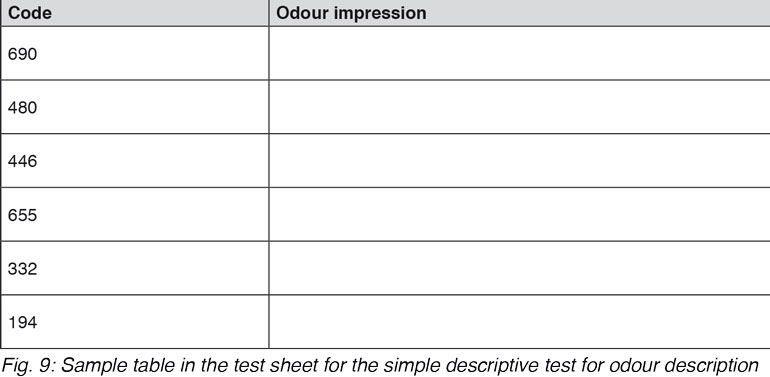
Odour identification tests can be carried out not only with defined individual substances or defined substance mixtures, but also with non-standardised flavours. Here the non-standardised flavours are generally produced with spices or foods or parts of foods in which the flavours to be identified occur not in isolated form, but integrated in a matrix. In some cases this type of odour recognition is easier for the persons being tested, as e.g. the complex mixture of all typical flavour-active substances is present in the food and not just one key flavouring substance.
5.2.2 Matching-Test
A further, relatively simple variant of the identification test is the matching test, of which there are many variants. For instance the test persons can first be presented with various samples of odour references for training and “familiarisation”. They are then given a series of coded samples that have to be allocated to the odour references in the original set. In a further simple variant, the analysts are given six to ten coded samples, of which two to three in each case contain the same flavouring substance. The analysts first have to sort and group these and then if required describe the odour.
5.2.3 Descriptive test
The descriptive test is used to practice verbal descriptions of unknown odours. By contrast with the recognition test (see 5.2.1, Fig. 8), no odour attributes are provided for selection. A descriptive test is also a component of a profiling test. Precise recognition of the chemical substances presented is not so important here, but instead the most objectifiable description possible of the sensory impression, so that in this case the method of the “simple descriptive test” can generally be used. Here the power to express sensory perceptions is required in order to develop a descriptive vocabulary for describing the flavour profile of the product samples presented. This type of test also allows a large number of other variations. For instance the analysts can be given an aroma/flavour wheel as an aid, or else lists of attributes with possible descriptors can be made available.
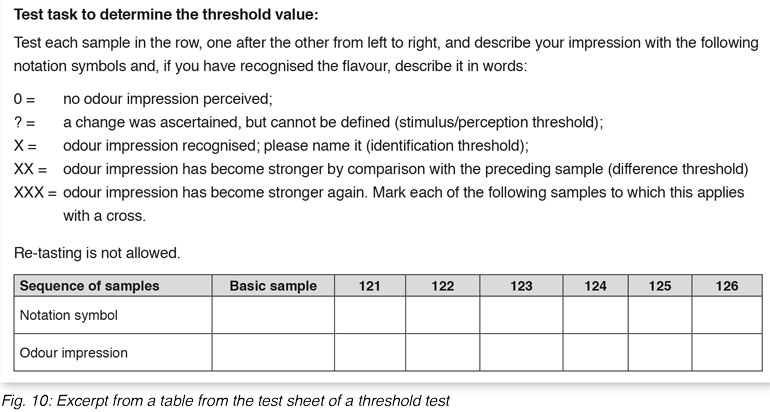
5.3 Odour sensitivity and intensity assessment
In practice it may be desirable to detect off-flavours as sensitively as possible with the help of a panel. In this case it is interesting to determine the odour sensitivity with respect to selected substances in the form of stimulus/perception and recognition thresholds. For intensity assessment the analyst must be able to reliably recognise slight differences in intensity. This can be achieved for instance with the help of discrimination tests and by determining the difference threshold.
5.3.1 Odour sensitivity
The stimulus threshold and the recognition threshold of an analyst for an odour substance can be determined in order to describe the odour sensitivity. These threshold values can vary widely depending on the medium used.

Accordingly several powers of ten can lie between the recognition thresholds of a fl avouring substance in air, water and beer. There are also differences between orthonasal (sniffi ng of a solution) and retronasal (tasting) perception of a fl avouring substance.
To determine the recognition threshold, a test substance is presented in rising concentrations for sniffi ng or tasting. Re-tasting is not allowed. This test fi rst fi nds out as of what concentration an odour impression is perceived (stimulus/ perception threshold). Then with rising concentration, the analysts smell and taste further and in each case state when a difference in concentration is perceived. Provided that the odour is identifi ed clearly, the analyst notes what odour this is (recognition threshold) and tests the sequence up to the end. Experience has shown that when this test is repeated there is frequently a risk of the analysts guessing and not concentrating on the actual test. Alternatively the stimulus or recognition threshold can be additionally secured or verifi ed with a discrimination test, such as the Duo Test or Triangle Test. Recommendations on the individual concentrations of the solutions with the identifi cation thresholds and evaluation options are listed in DIN 10959. (See Fig. 10)
5.3.2 Recognition of differences in intensity
Alongside the qualitative recognition of odours, recognition of intensity differences in standardised odours is also important within the context of screening and monitoring analysts. This ability is a prerequisite for assessing the intensity of flavours.
In principle all discrimination tests (difference or comparison tests) can be used in order to examine the ability to recognise differences in intensity. (For further information on this contact sensorik@DLG.org).
Pairwise comparison tests and triangle tests with a standardised aroma in two concentrations are particularly suitable. If more than two concentrations are to be compared, the ranking test can be used. In this test at least three samples of a fl avouring substance with different concentration levels are produced and handed out together to the panellists for testing. The test task consists of arranging the samples in the sequence of rising concentration of odour intensity perceived (ranking) and noting this intensity sequence using the sample numbers (see Fig. 11). The flavouring substances selected for the difference test should be important for the product that is subsequently to be tested (see Table 12). Further information can be taken from DIN ISO 8587: 2010-08 Sensory Analysis – Test Methods – Ranking Test.
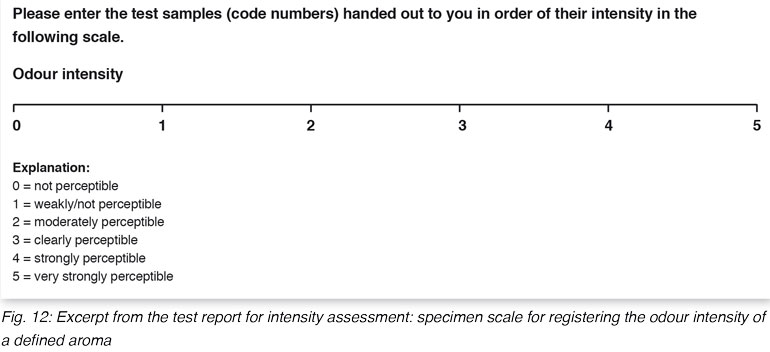
5.3.3 Intensity evaluation
The intensity of an odour substance is evaluated with the help of a scale prescribed by the test leader. Both ordinal scales (verbal description of the extent of the attribute, for instance low – high (e.g. Fig. 11) and metric scales (extent of the attribute defi ned in fi gures, e.g. 0 to 5, see Fig. 12) are applied. Using the intensity scale is the subject of an analyst training session. Intensity evaluations are part of the profile tests and the tests of building products or materials entering into contact with food for unwanted odour substances. In addition to a verbal description of the intensity, reference materials for certain intensity stages or a whole series of intensity stages with a selected aroma are helpful.
Product-specific training is carried out after the intensity training for individual flavouring substances. Depending on the objective and the possible assignments of the panel, different product variants are offered for testing here. It should be noted that ideally the test sequence is evaluated in triple repetition, as a final selection of the chosen panellists is possible by looking through the data gained in this way and comparing the panel performance characteristics.
Those analysts who display a high standard deviation between the repetitions in the test results or who cannot discriminate well between the products are not suitable for a quantitative panel. Panellists who display only a low level of diffi culty in this connection can be qualifi ed appropriately via further product-specific training units.
Conclusion
The objective of this Expert Knowledge Report was to provide an insight into the olfactory perception and general fundamentals of characterising flavours, as well as to supply an overview of the key methods of odour training for panellists. The report makes it clear that in addition to regular training and examining of knowledge about the basic taste types, aroma/flavour training especially should play a significant role in qualifying sensory analysis panellists. The report presents various odour training modules that can be used for both selection and training and also within the context of a monitoring programme. After starting with the use of isolated odour references, as the level of knowledge increases and in line with sensory experience, it is possible to move on successively to training work with flavourings in the food matrix. This generally proves to be more complex and thus more difficult. Depending on the tasks to be performed by the panel and on the basis of the defined performance factors and requirements made of the panellists, it is thus possible to design a focused training plan and with the help of continuous performance monitoring to adapt this steadily to the level of sensory knowledge of the panellists and successively increase the panel’s performance capability. The field of aroma/flavour theory and training is extremely complex and offers much potential for development and further food for discussion in future, not only in human sensory analysis, but also in the field of “Instrumental Sensory Analysis”.
Literature:
- Mleczko, M., HS Anhalt: Panelschulung: Einsatz von standardisierten Geruchsproben zur Schulung der Geruchserkennung im Lebensmittelbereich (Bachelorarbeit 2015)
- Uhl, M., HS Geisenheim: Erstellen eines Leitfadens für das Fachvokabular von Getränken (Bachelorarbeit 2015)
- Legrum, W., Riechstoffe zwischen Gestank und Duft, Springer Verlag 2015
- Hans-Dieter Belitz, Werner Grosch: Lehrbuch der Lebensmittelchemie, Springer, Berlin, 3. Aufl. 1987, S. 274
- Vilgris, T.; Vierich, T., Aroma: Die Kunst des Würzens, Stiftung Warentest, 2013
- Busch-Stockfisch, M., Kapitel 2: Prüferauswahl und Schulung in Praxishandbuch Sensorik, Behrs Verlag GmbH & Co.KG, Hamburg
- DIN EN ISO 8586: 2014-05 „Sensorische Analyse – Allgemeiner Leitfaden für die Auswahl, Schulung und
- Überprüfung ausgewählter Prüfer und Sensoriker“
- Derndorfer, Eva, Lebensmittelsensorik, Facultas Verlags- und Buchhandels AG, Wien, 2010
- DLG-Expertenwissen „Sensorische Analyse“, www.DLG.org/expertenwissen_sensorik.html
- Bargs-Stahl, E.; Luck-Haller, Dr. E., - www.planet-schule.de/wissenspool/total-phaenomenal-sinne/inhalt/hintergrund/der-geruchssinn/mensch.html (retrieved: 25.05.2016)
- https//de.wikipedia.org/wiki/Riechschleimhaut, retrieved: 19.07.2016
- de.wikipedia.org/wiki/Riechkolben, retrieved: 19.07.2016

